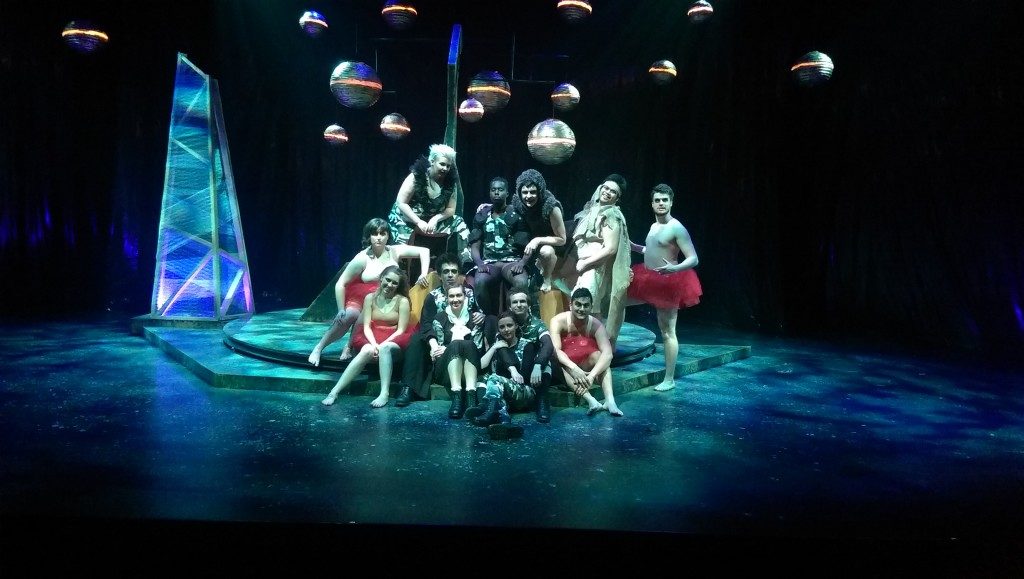
‘A Midsummer Night’s Dream’ play review
By Caroline Ho, Arts Editor
Douglas College’s latest Winter 2017 production, which opened on Friday, entices audiences into the shadowy world of Shakespeare over the course of one enchanting evening.
A Midsummer Night’s Dream, directed by Thrasso Petras and produced by the Departments of Theatre and Stagecraft & Event Technology, runs in the Laura C. Muir Performing Arts Theatre until Friday, March 24.
The first thing to note about the play is the atmosphere, which draws you into the soporific setting from the very start. Before the show begins, the quiet, lulling forest sounds of owls and crickets play softly in the background. But no need to worry about dozing off—once life bursts onto the gorgeously-constructed, lantern-lit set, the action is unmissable.
Speaking as someone who never thought they could like Shakespeare, and who admittedly hasn’t had much exposure to the playwright outside of high school English class, I was pleasantly surprised to find how immersed I was in the play. I thought I’d find the language stilted and the vocabulary obsolete, but the actors make it immediately accessible, and the verses (and donkey puns) flow naturally.
The costumes do seem considerably less traditional than one might expect from a Shakespeare play. All of the Athenians wear camouflage-patterned clothes and black combat boots, but somehow it’s entirely appropriate for the mood. The outfits of the fairies also work excellently: Cobweb (Chloë MacDonald-Comely), Moth (Arjun Panesar), Mustardseed (Allie Melchert), and Peaseblossom (Michael Bernard) are clad in bright red tutus.
Between the clothes and the fluid movements of the actors, the fairy characters possess a certain bounciness and otherworldliness that’s both whimsical and faintly, preternaturally unnerving. This is especially true of the fairy Puck (Christian Krushel), who takes mischief to the extreme and delights in carrying out the orders of the fairy king and queen Oberon (Noah Oryema) and Titania (Lexie Butler) with as much havoc wreaked as possible. When watching the schemes of the fairies, you get a very real sense of their not-human attitudes toward mortal emotion and suffering.
A Midsummer Night’s Dream is undeniably humorous. Particularly comedic are the exuberant wannabe-actor Bottom (Sargil Tongol) and his fellow players Flute (Panesar), Quince (MacDonald-Comely), Snout (Bernard), and Snug (Melchert). The melodramatic comportments of these characters truly bring to life their performances-within-a-performance. It takes skill to play an inanimate object, but it takes even more skill to be an actor playing an amateur actor playing an inanimate object, which is pulled off hilariously.
The production advertizes itself as dark as well as comedic. According to the program, the play is performed to show the “shadow side of love.” This aspect shows throughout, particularly with the young Athenian lovers, starting from Hermia (Frances Warwick) being threatened with death by her own father for being in love with Lysander (Colin Amor), to Helena’s (Ashley Chodat) affections for Demetrius (Blake Hobson-Dimas) to the point of begging for abuse, to the intense behavioural changes that take place once the characters are ensorcelled by the fairies. Passions are amplified by the magic, yet the desire and lust portrayed by the actors are still recognizable forms of base human emotions.
The best-handled part of the play was how deftly it switched between humour and seriousness, with shifts in mood augmented by subtle lighting changes. You’re taken from laughter at the ludicrous to unease at the potential for sexual violence within moments; like in a dream, you’re never quite sure where the exact point was when the mood slides from one to the next. And with the tasteful smoke effects and the fairies’ provocative playfulness throughout the play, by the end of the night you’re left with that faintly disbelieving sense of dreamlike wonder.

